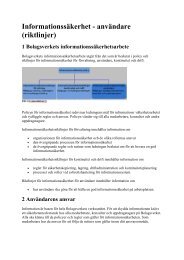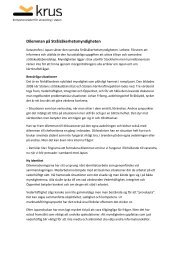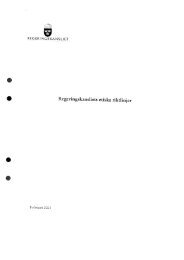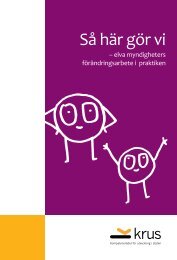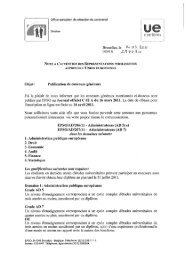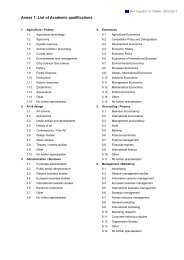Dialogkompetens i skolans vardag - Publikationer - LTU - Luleå ...
Dialogkompetens i skolans vardag - Publikationer - LTU - Luleå ...
Dialogkompetens i skolans vardag - Publikationer - LTU - Luleå ...
Create successful ePaper yourself
Turn your PDF publications into a flip-book with our unique Google optimized e-Paper software.
Background<br />
Listening Environment in School 3<br />
In the Swedish school system there is a distinction between schools for the<br />
deaf run by the state and schools for hard-of-hearing pupils run by local<br />
authorities (municipalities). The educational language in schools for the deaf<br />
is sign language, whilst in schools for the hard-of-hearing it is spoken<br />
Swedish. The focus for this study is five local schools that provide classes for<br />
hard-of-hearing pupils. These schools have an average number of seven to<br />
eight pupils per class, and offer acoustically adapted classrooms with<br />
technical equipment, e.g. hearing loops. Two different microphones can be<br />
used with hearing loops: either a wireless and flexible conference system with<br />
the microphone placed in the middle of the table, or an individual<br />
microphone with a locked position at each desk. The desk alternative can<br />
be controlled with a mechanical on/off button (the traditional system) or by<br />
voice (see www.rnid.org.uk). Sign language is taught as a subject once or<br />
twice a week. This is not to be compared with a bilingual situation, since most<br />
of the pupils and teachers are unable to use the language fluently. In classes<br />
for hard-of-hearing pupils there is a need for the use of hearing aids 1 in the<br />
environment as well as, on occasion, the use of signs from sign language in<br />
addition to speaking.<br />
This study originated during the school improvement project mentioned<br />
earlier, in which teachers tried to change the learning environment for<br />
hard-of-hearing pupils in order to promote a more dialogue-oriented<br />
and participatory classroom communication. The traditional technological<br />
solutions had contributed to an inflexible arrangement of furniture in<br />
the classroom. The desks were positioned in the shape of a half circle and<br />
linked together with wires for individual desk microphones. The teacher<br />
used a wireless microphone whilst the desk microphones for the pupils<br />
were supposed to be turned on and off manually when each pupil wished<br />
to speak. When pupils did not activate their microphones, this also<br />
prevented other pupils from listening via the hearing loop. In order<br />
not to risk a misunderstanding, pupils preferred to speak to the teacher<br />
rather than to their classmates, which led to a relatively passive approach<br />
amongst pupils in the classroom (Ahlström & Preisler 1998). One<br />
might say that in such classrooms the teacher significantly controlled<br />
the classroom communication. In a description of the improvement<br />
process mentioned above, a very experienced teacher expressed the following<br />
view:<br />
1 Hearing aids are personal aids that can have three different settings (m, t and m/t).<br />
. Microphone (m)-setting: The microphone of the hearing aid picks up and amplifies the sound<br />
(speech and background sound).<br />
. Telecoil (t)-setting: A hearing loop is used to amplify and transmit to the hearing aid what<br />
pupils close to the desk microphone are saying; the background noise is cut off.<br />
. Microphone/telecoil (m/t)-setting: The microphone and the hearing loop amplify and transmit<br />
the sound at the same time. Very few pupils have this setting on their hearing aid.



